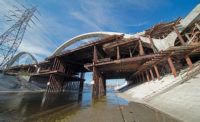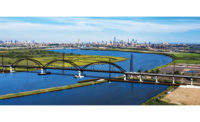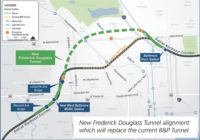Amtrak unveiled on July 23 a plan for a system that would provide three train trips a day between Phoenix and Tucson, at an estimated capital cost of $925 million. The route would include seven new stations and tie into the existing Amtrak Sunset Limited east-west route with an existing station in Tucson.
Bill Flynn, Amtrak CEO, said in a Zoom media roundtable that the railroad has spent several years developing the vision, in consultation with Arizona leaders. Stephen Gardner, Amtrak president, noted that 11 Arizona mayors sent a bipartisan letter to Congress this month in support of the plan.
“We think Arizona is ripe for this type of service,” Gardner said. “We are proposing an achievable time of 2 hours 25 minutes,” which is about the same as driving between the two cities.
Amtrak expects the line would attract 200,000 annual riders, generate $77 million in annual economic activity, and $2.3 billion in economic value from capital investment, Gardner said.
Once funding and environmental approvals are secured, construction is expected to take about three years. “The first step is to get deeper into the planning,” said Gardner. “We’ll look at feasibility of the route and get into the specifics required to develop the service…I could see us jumping into that quickly.”
If the $1.2-billion Bipartisan Infrastructure Framework passes in Congress, it would include $66 billion for Amtrak. Rep. Greg Stanton (D-Ariz.) noted that the House passed a bill that would fund Amtrak at $32 billion over five years, three times higher than current levels.
The INVEST in America Act also includes two grant programs that would offer $50 billion over five years to programs that improve mobility and infrastructure and expand intercity passenger rail.
Amtrak has asked the federal government to fund a 15-year, $75-billion plan to add service for 160 new communities.
“Amtrak put forward a bold plan for federal investment to help cover up to all initial capital costs and a portion of operating costs” for the first year, Gardner said. “We’ll wait to see how Congress considers it.”
Tucson Mayor Regina Romero said the bipartisanship of mayoral support “goes to show how important infrastructure is…Bringing rail between the two cities represents common-sense investment.”
She added that rail service would reduce congestion “in what historically a more dangerous stretch of Interstate 10,” improve travel times for trucking and commerce on I-10, and spur private investment. “Look at the economic activity of our Sunlink streetcar,” she said. “We saw more than $1 billion of private investment because of the federal investment in Sunlink.”
After initial federal investment, “we need to develop a funding stream with the state and local communities,” said Gardner. Amtrak also will need to reach agreements with Union Pacific to use its right of way, he added.






Post a comment to this article
Report Abusive Comment